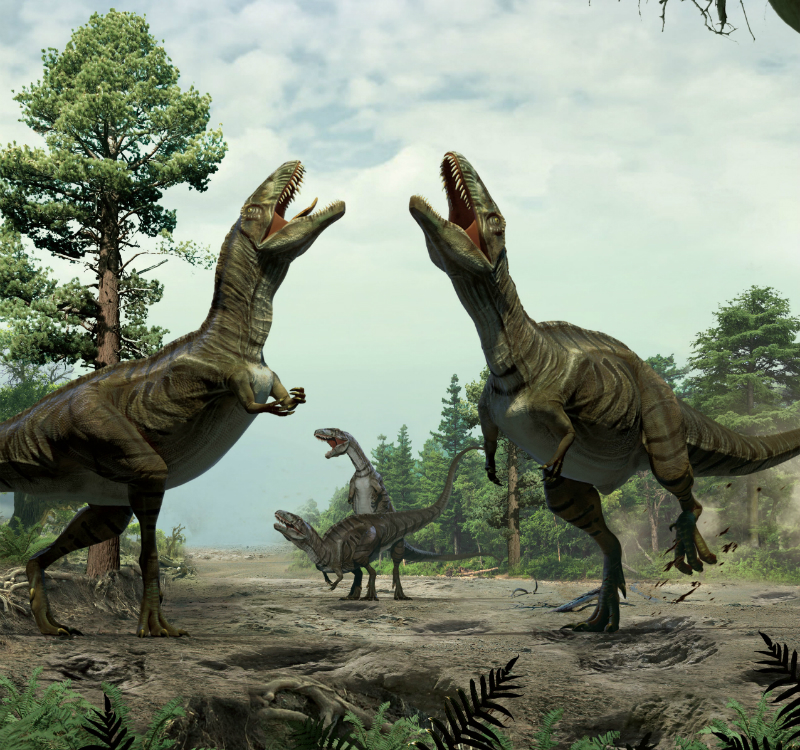
How Did Dinosaurs Communicate?

Dinosaurs didn't have email or text messages to keep in touch, but scientists are quite certain the beasts engaged in dialogue. Those communications likely included hoots and hollers, cracking sounds, dance and song, and even symbolic love calls made with showy plumage.
Clues from the fossil record and related, living animals, such as birds and crocodiles, hint at the ways the ancient creatures may have communicated, said Thomas Williamson, curator of paleontology at the New Mexico Museum of Natural History and Science.
"We rely heavily on modern animals to make inferences about extinct animals," Williamson told Live Science. [Is It Possible to Clone a Dinosaur?]
Coos, booms and hoots
Dinosaurs may have made closed-mouth noises, much like the booms and hoots that some birds make today, according to a study published in July 2016 in the journal Evolution.
"Closed-mouth vocalizations are sounds that are emitted through the skin in the neck area while the beak is kept closed," said study lead researcher Tobias Riede, an assistant professor of veterinary physiology at Midwestern University in Arizona. "To do so, birds typically push air that drives sound production into an esophageal pouch, rather than exhale through the open beak."
The coos of doves are a good example of this behavior, he said.
To figure out how closed-mouth sounds arose, the researchers analyzed the distribution of this ability in birds and other reptilian groups, Riede said. The scientists found that these hoots evolved at least 16 times in Archosaurs, a group that includes birds, dinosaurs and crocodiles.
Sign up for the Live Science daily newsletter now
Get the world’s most fascinating discoveries delivered straight to your inbox.
"Interestingly, only animals with a relatively large body size (about the size of a dove or larger) use closed-mouth vocalization behavior," Riede told Live Science in an email.
He added that "since dinosaurs are members of the Archosaur group, and many had large body sizes, it is likely that some dinosaurs made closed-mouthed vocalizations in a manner similar to birds today."
Frills and dances
Extinct dinosaurs — like their living relatives, modern birds — may have "talked" via song, dance, scent and colorful plumage, Williamson said.
The horns, frills and crests that adorned dinosaur heads may have been used for mating rituals or to intimidate rivals. For instance, fossils show that a Triceratops relative (Protoceratops andrewsi) developed larger frills and cheek horns as it matured, suggesting that these decorations helped the species communicate, and possibly catch the attention of mates.
These horns and frills may have also conveyed the dinosaurs' dominance and age to others of their kind, the researchers said in the January study, published in the journal Palaeontologia Electronica.
Dinosaur fossils have offered other tantalizing clues about the animals' senses. Based on the size of their eyes and the vision of their relatives (that is, birds and crocodiles), it's likely that dinosaurs had excellent color vision, Williamson said. Plus, recent discoveries of color patterns on dinosaur feathers suggest that colorful feathers might have played a role in signaling, he said.
Deep dino-sounds
Some duck-billed dinosaurs, called hadrosaurs, had elaborate crests that contained long and resonant extensions of the breathing tracts. Williamson and colleagues found that these crests are naturally resonant and so could easily produce low-frequency sounds. [See photos of a 'Superduck' hadrosaur with a lizard-like skull crest.]
"Based on the physical properties of the bones that transmitted sound between the eardrums and middle ear, we know that these dinosaurs were capable of hearing the sounds produced by the crests of other hadrosaurs," Williamson said.
The extremely long tails of Diplodocus and other sauropod dinosaurs could also have made some noise. Some researchers have suggested that the tips of these tails could have been flicked at supersonic speeds, making bullwhip-like cracking sounds that may have traveled long distances.
Moreover, ankylosaurs had elongated and convoluted respiratory tracts that might have been used to make or modify sounds used for communication. And the huge sauropod dinosaurs had long respiratory tracts in their long necks that, quite possibly, produced low-frequency sounds, Williamson said.
Based on analyses of dinosaur ears, scientists concluded the beasts had excellent low-frequency hearing, Williamson said. Such low-frequency sounds could "penetrate through thick vegetation and over large distances, and may have allowed individual dinosaurs to be heard over vast areas," Williamson explained.
"The Mesozoic must have been an amazing place, made all the more noisy and colorful by the communications of dinosaurs," he said.
With additional reporting by Corey Binns.
Original article on Live Science.

Laura is the archaeology and Life's Little Mysteries editor at Live Science. She also reports on general science, including paleontology. Her work has appeared in The New York Times, Scholastic, Popular Science and Spectrum, a site on autism research. She has won multiple awards from the Society of Professional Journalists and the Washington Newspaper Publishers Association for her reporting at a weekly newspaper near Seattle. Laura holds a bachelor's degree in English literature and psychology from Washington University in St. Louis and a master's degree in science writing from NYU.










